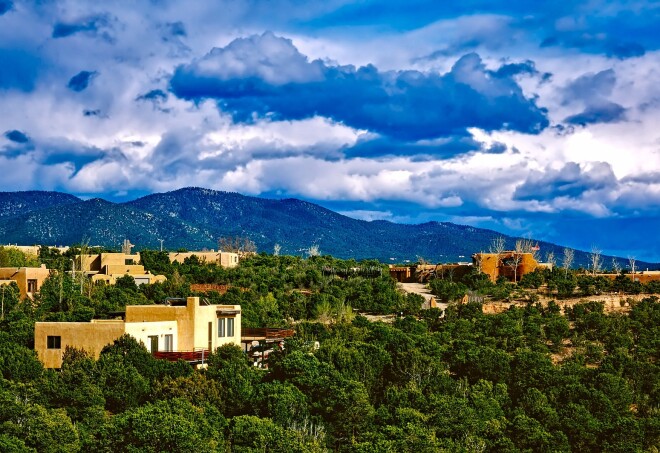Overview
When’s the best time to go to Santa Fe?
Summer’s warm months are busy with cultural events, including a world-class opera, art fairs, and chamber music. Fall promises a change in colors as aspen trees turn golden and freshly harvested Hatch chilies come on the market. The colder (less touristy) winter months usher in powdery snow for skiers, and festive walks along winding Canyon Road offer a glowing backdrop of farolitos (small candles). While spring’s arrival can feel a bit late, the crowds are still thin, so it’s a perfect time for outdoor strolls and more vigorous hikes.
How to get around Santa Fe
Visitors arrive at either Albuquerque International Sunport Airport or the smaller Santa Fe Municipal Airport. The 90-minute Rail Runner commuter train runs from Albuquerque (a quick shuttle bus takes you to the train from Sunport) to Santa Fe. The reasonably priced Sandia Shuttle Express van makes frequent airport runs, dropping off at various Santa Fe locales. To properly explore and enjoy long scenic drives, rental cars are readily available at the airport.
For easy access to the surrounding desert and landscapes, it’s best to rent a car. But once you’re in town, Santa Fe is extremely walkable. A leisurely stroll takes you around the Plaza (the heart of downtown) or up legendary Canyon Road and through the contemporary arts scene in the vibrant Railyard District. Various hiking and biking trails beckon those who crave outdoor activities.
Can’t miss things to do in Santa Fe
The New Mexico State Capitol, known as the Roundhouse, holds an impressive art collection. It includes 600 pieces (paintings, photographs, sculpture, textiles, mixed-media), spread over four floors, but easily accessible and free to visitors. The extensive collection is limited to works created by artists who live in New Mexico.
Food and drink to try in Santa Fe
The diverse dining scene is a melting pot of Spanish, Mexican, cowboy, Mediterranean, and Pueblo Native American influences. Earthy tamales, enchiladas, and chiles rellenos are classic Southwestern offerings. The official New Mexico state question, “Red or green?” asks what chili sauce you want smothering your dish. (Red is more pungent, green is packed with heat.) For a taste of both, the marriage of red and green sauces is known as Christmas. Margaritas are abundant on drink menus, alongside craft brews and award-winning local sparkling wines.
Culture in Santa Fe
The original Native American tribes in the region were joined by the Spanish settlers in the 16th century. Today you can expect a melting pot of these and Anglo influences, and a colorful spectrum of traditions. The merging of the Old and New Worlds has resulted in a fascinating and unique style of architecture that can be seen in centuries-old haciendas, colonial buildings, and Spanish churches.
In summer, shoppers arrive for the popular Indian Market, which brings together over 1,200 artists from 100 different tribes, and the Folk Art Market, which showcases textiles, toys, and jewelry. Fall is the time for the Santa Fe Fiesta, celebrating the town’s 1692 settlement with concerts and a carnival. The Spanish Market showcases traditional Spanish colonial arts, and Christmastime brings festivities along Canyon Road amid a warm glow of lights.
Local travel tips for Santa Fe
At this high elevation, locals frequently apply, and reapply, effective sunscreen, and it’s good to note that the effects of one alcoholic drink at this altitude equals around three elsewhere—so tread lightly on those delicious margaritas and specialty beers. For those who have trouble adjusting to altitude, try a massage catering to what ails, or a dose of the locally produced ChlorOxygen, a chlorophyll herbal remedy that purports to increase your blood’s capacity to hold oxygen. And, in the food category, locals eat the fluffy fried pastries (known as sopapillas) after their meal.






